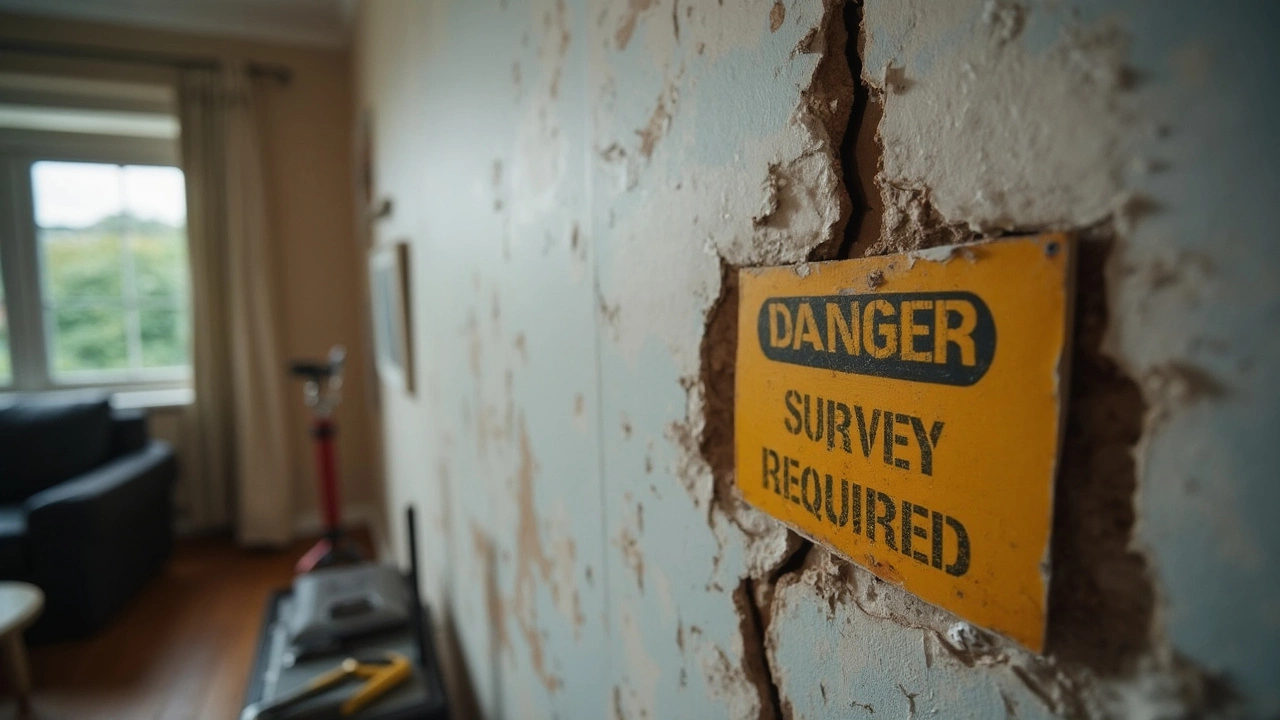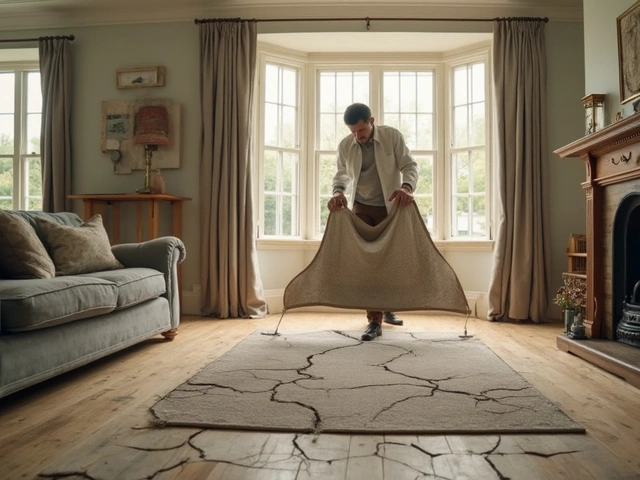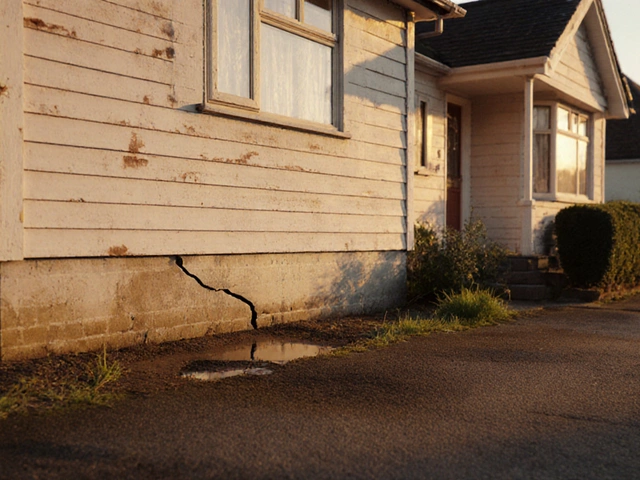Most Expensive Thing to Fix in a House: What Really Breaks the Bank?

If you ever play the game of “what’s the most expensive thing to fix around here?”—spoiler alert—most homeowners aren’t worried about peeling paint or a broken window. The real monsters are the invisible fixes, the ones you can’t see till you trip over a weird crack or the floor suddenly sags. Stuff like foundation repair can cost more than a new midlife crisis sports car. It’s not just about money, either. When that bill slams your inbox, it can put your whole renovation on ice.
Think about it: you can live with a squeaky door, but if your foundation shifts, every single thing in your house is at risk. Doors don’t close, cracks show up everywhere, even the plumbing starts acting like it’s haunted. And the wild part? Most folks don’t even see it coming. You won’t notice until the signs are screaming at you—and by then, it’s way past a DIY fix.
- Biggest Repair Bill Culprits
- Why Foundations Fail (and What to Look Out For)
- Roofing Nightmares: More Than Just Leaks
- Hidden Dangers: Plumbing and Sewer Shocks
- Electrical Issues: Sparks That Empty Wallets
- How to Dodge Jaw-Dropping Repair Costs
Biggest Repair Bill Culprits
Most people assume the priciest home repair is kitchen remodeling or a fancy new roof, but the truth hits harder. It's not the stuff you show off—it's the stuff that's quietly falling apart in the background. When a house starts to fail, a few repairs can completely crush your renovation budget, and some of these are way more common than you’d think.
Here’s a quick rundown of the bills that leave folks stunned:
- Foundation repairs – These creep up slowly and can cost anywhere from $4,000 for a few piers up to $35,000 or more for total stabilization. Houses in regions with clay soil or lots of moisture are at higher risk. When your foundation shifts, every other repair becomes urgent.
- Roof replacement – Missing shingles don’t sound like a big deal, but a new roof can set you back $8,000 to $22,000—it adds up fast with larger homes or fancy materials. Putting it off means water leaks, mold, and even ruined framing.
- Full plumbing overhauls – Galvanized pipes are a ticking time bomb. Replacing all plumbing in an old house can climb over $15,000, and that’s not counting damage from leaks or water cleanup.
- HVAC systems – Sure, a new furnace alone might be $5,000, but if ductwork needs replacing or you’re switching to central air, expect $18,000+. Repairs don’t come cheap, especially when a system fails in peak winter or summer.
- Sewer line replacement – Not the kind of thing you notice until the toilets stop flushing. Digging up and replacing the main sewer line costs between $3,000 and $15,000, depending on your yard layout and street access.
- Electrical wiring upgrades – Old and unsafe wiring is a fire hazard. A full rewire, especially in houses with knob-and-tube or aluminum wiring, often costs $8,000 to $20,000. Some insurance won’t even touch you if this isn’t up to code.
It's wild how these jobs add up, especially if your house is older. Here’s a quick look at what some of these repairs cost in 2025:
| Repair Type | Average Cost (USD) | Worst-Case High (USD) |
|---|---|---|
| Foundation Repair | $10,000 | $35,000 |
| Roof Replacement | $15,000 | $22,000 |
| Full Plumbing Replacement | $12,000 | $18,000 |
| HVAC System Replacement | $10,000 | $18,000 |
| Sewer Line Replacement | $7,000 | $15,000 |
| Electrical Rewiring | $12,000 | $20,000 |
When budgeting for your next project, don’t just look at the fun stuff like floor tile or paint. Keep an eye (and some extra money) on these budget-busters—your wallet will thank you when those hidden disasters show up.
Why Foundations Fail (and What to Look Out For)
Foundations hold your house together, literally. So, when something goes wrong here, you're talking about the most expensive home repairs on the list. Big-ticket disasters like cracked slabs, settling, or shifting aren’t just headline-grabbers—they’re straight-up wallet-busters.
Most foundation fails come down to water. Either there’s way too much, not enough, or it’s not draining right. Clay soils love to expand and shrink depending on the weather. The same patch of Texas dirt that’s dry as bone one year might turn into soup the next. That movement? It makes houses drift, tilt, and crack.
Check out what the American Society of Civil Engineers says about the issue:
"Expansive soils are responsible for more damage to U.S. structures annually than floods, hurricanes, and tornadoes combined."
Trees growing close to your walls can suck up all the moisture, while gutters dumping water at your foundation can drown it. The weather isn’t your only problem. Poor construction, thin slabs, or shoddy compacting below the house also set up a world of hurt years down the line.
What are the red flags? Here’s a quick hit list to check before things get out of hand:
- Cracks wider than a pencil in walls, floors, or ceilings
- Doors and windows sticking or refusing to close smoothly
- Floors that suddenly slope or feel springy
- Gaps around window frames or exterior doors
- Water pooling near the base of the house after rain
Want a sense of just how big of a deal foundation repairs can be? Here’s a table with ballpark figures based on 2024 quotes from U.S. repair companies:
| Problem Type | Average Cost (USD) |
|---|---|
| Minor crack repair | $500 - $2,500 |
| Slab jacking | $2,500 - $7,000 |
| Piering (serious settling) | $10,000 - $40,000+ |
Spotting all this early can save you a mountain of stress. If you get a weird feeling about your floors, or notice cracks that won’t go away, get an inspection from someone who knows their stuff. It beats shelling out for a full house rescue later.
Roofing Nightmares: More Than Just Leaks
When folks hear "roof repair," most just picture a drip-drip-drip in a bucket. The real hurt comes when that simple leak turns out to be a sign of much bigger trouble, like rotted wood, wrecked shingles, or a sagging structure that needs a full replacement. Here’s the shocker: roofing problems can rack up bills from a few hundred bucks for a patch-up, all the way to $20,000 or more if they’ve snuck in for years. In 2024, the average cost to replace a roof in the U.S. was around $11,500, but high-end materials or complex roofs can send you way above that number.
Water doesn’t just stain the ceiling—it messes with insulation, fries electrical systems, invites mold, and can even mess up your home’s entire framework. Not to mention, insurance can deny your claim if you ignored "minor" problems too long. Most expensive home repairs related to roofing would be caught early if people checked their attics once in a while.
- Missing shingles: An open invitation for water damage.
- Sagging patches: Usually from trapped moisture chewing up the support beams.
- Granules in the gutter: Your shingles are shedding and need attention.
- Sunlight in the attic: If you see sky, you’ve missed routine checks.
You can’t just slap new shingles on top if the whole shebang is rotten underneath. That’s why roofers always talk about “tear-off” jobs, which are pricier but save a ton of trouble later on. Here’s a quick look at average national costs from 2024:
| Repair/Replacement Type | Average Cost (2024) |
|---|---|
| Patching Minor Leak | $400 - $1,200 |
| Structural Roof Repair | $4,000 - $10,000 |
| Complete Roof Replacement (Asphalt) | $9,000 - $14,000 |
| Premium Roof (Metal, Tile, Slate) | $17,000 - $32,000 |
Pro tip: Do a roof inspection every spring and fall. Look for cracked or missing shingles with binoculars if you don’t love heights. And if you spot granules in your gutters, don’t brush it off. My buddy waited too long—ended up with mold in his attic and needed new insulation too. Double whammy.

Hidden Dangers: Plumbing and Sewer Shocks
Plumbing and sewer problems are the sneaky villains of home repairs. Pipes sit quietly behind your walls or under your floors, minding their own business—until they burst, leak, or clog up so bad your basement floods. Suddenly, you’re looking at water everywhere and a repair bill big enough to make you sweat.
The average sewer line replacement today in the US can hit anywhere from $3,000 to over $15,000, depending on what’s actually broken and how tricky the spot is. And it gets worse with older homes—ones built before 1970 may have clay or cast iron pipes, which basically have a built-in expiration date. These love to crack, corrode, or even get shredded by tree roots looking for a drink.
Here’s something you don’t want to ignore: if your toilets gurgle, sinks drain slow, or you hear weird water sounds behind the walls, stop and investigate. According to the EPA, about one trillion gallons of water get wasted every year due to household leaks. That’s not just a hit to your water bill—it could mean serious water damage and mold hiding where you can’t see.
“Sewer repairs can be disruptive and expensive, but early detection can save homeowners thousands in damages,” says Eric Snell, a certified master plumber from Seattle.
If you want to dodge those big repair bills, stay on your toes with regular checks. Look for these red flags:
- Unexplained wet spots in the yard (especially if it hasn’t rained)
- Low water pressure throughout the house
- Mysterious smells, kind of like rotten eggs, inside or outside
- Repeated drain clogs, not just in the same sink but all over
You can bring in a plumber for a quick inspection with a camera probe. This isn’t just for peeking at issues; it can confirm if you’ve got a small clog—or a half-collapsed pipe buried under your driveway. That difference can mean going from a few hundred bucks to tens of thousands in repair costs.
Check out how plumbing repair costs stack up compared to some other big fixes:
| Repair Type | Average Cost (US) |
|---|---|
| Sewer line replacement | $3,000 - $15,000 |
| Major pipe leak repair | $1,000 - $4,000 |
| Minor pipe leak fix | $150 - $600 |
| Main drain clog | $350 - $2,000 |
Bottom line? Plumbing and sewer repairs can easily turn into one of the most expensive home repairs you’ll face. The trick is to pay attention early and act fast, before small leaks turn into wallet-busting disasters.
Electrical Issues: Sparks That Empty Wallets
No one ever brags about blowing thousands on new wiring. But ask anyone who’s had an old house, and they’ll tell you: electrical problems can eat through a budget faster than a kid through a bag of Halloween candy. It's not about fixing a dead outlet. If you need a full rewire, a new main panel, or have to update everything to code, your wallet’s going to feel it.
Let’s put it in numbers. Rewiring a typical 2,000-square-foot house in the U.S. often costs between $8,000 and $15,000—and that’s if things go smoothly. Need a new electrical panel? That’s another $2,500 to $4,000 depending on your area and how much rewiring’s needed. Plus, if electricians find ancient knob-and-tube wiring or aluminum wires (common in homes built before the 1970s), you’re looking at extra work to get things safe and insurable.
Here’s a look at what might be hiding behind your walls—and what it can cost to fix:
| Electrical Problem | Typical Cost (USD) |
|---|---|
| Full house rewiring (2,000 sq ft) | $8,000 - $15,000 |
| Electrical panel replacement | $2,500 - $4,000 |
| Knob-and-tube removal | $5,000 - $12,000 |
| Outlet replacement (whole house) | $1,000 - $2,500 |
| Fixing code violations | $1,500 - $5,000 |
Why does this all get so pricey? A lot of the labor is hidden—running new wires behind drywall, replacing old service panels, and sometimes patching walls after. Plus, you can’t mess with anything not up to code or safety standards. City inspectors take it seriously for good reason: ancient wiring is a massive fire risk. In fact, the National Fire Protection Association says electrical issues cause about 51,000 house fires per year in the U.S.
So, how do you keep your renovation budget from getting zapped? If you’re house hunting, get a licensed electrician to check things out before you buy. If you’re already living there and the lights flicker or breakers trip for no reason, don’t just ignore it. Signs like scorched outlets or buzzing sounds are red flags. Addressing them early often means smaller fixes, not a full overhaul. And if you think you can DIY anything more complicated than swapping a bulb or a cover plate, just don’t—big electrical jobs are for pros only. Safety first, always. Trust me, my Quincy is allowed nowhere near the breaker box, and Rex doesn’t even like the vacuum.
Electrical problems may not be as obvious as a leaky roof, but they sit at the top end of most expensive home repairs for a reason. Stay sharp, stay safe, and budget for surprises—because sparks are only fun on the Fourth of July, not in your living room.
How to Dodge Jaw-Dropping Repair Costs
No one wants a mega-sized bill for home repairs, but they’re surprisingly easy to avoid if you keep your eyes open and act early. Most big costs start as small problems, so the trick is to catch them before they blow up your budget. Grab a flashlight and get nosy—those small cracks and leaks can give you fair warning before you’re stuck with a five-digit invoice.
The best strategy? Regular check-ups. Not fancy, but super effective. Experts say doing a full walk-around your house every season helps spot trouble before it multiplies. And don’t just glance—open cabinets, peek under sinks, and walk around the outside foundation, too. Pay special attention to basements and crawl spaces; this is where foundation mischief and water damage love to hide.
- Most expensive home repairs usually start with ignored warning signs. Mark your calendar for a yearly roof and foundation inspection, even if things look okay.
- Don’t cheap out on gutter cleaning—clogged gutters redirect water straight to your foundation. One $200 cleanout beats a $30,000 foundation repair every time.
- If you have mature trees, check their roots aren’t creeping toward your pipes or slab. Slow-growing cracks or strange plumbing noises? Get those checked before they get worse.
- Install water sensors near sump pumps and below sinks. These gadgets can save you from nasty sewer backups or basement floods, and most cost less than a dinner out.
- Keep an eye on your home’s humidity. Too dry or too wet is bad news for structure. Shoot for 30-50% humidity inside—pick up a cheap monitor off Amazon and glance at it monthly.
Here’s what catching repairs early versus late can do for your bank account:
| Repair Type | Average Early Cost | Average Late Cost |
|---|---|---|
| Foundation Crack | $500–$2,000 | $15,000–$45,000 |
| Leaky Roof | $300–$1,200 | $8,000–$20,000 |
| Pipe Leak | $150–$600 | $5,000–$15,000 (if ignored and flooding occurs) |
Don’t wait until Quincy or Rex trips on a buckled floorboard. The sooner you jump on these repairs, the more cash you’ll keep in your pocket—and the more weekends you’ll spend relaxing, not fighting with surprise bills.


